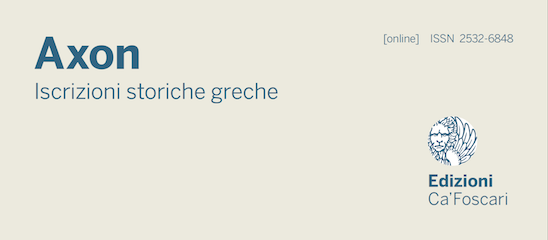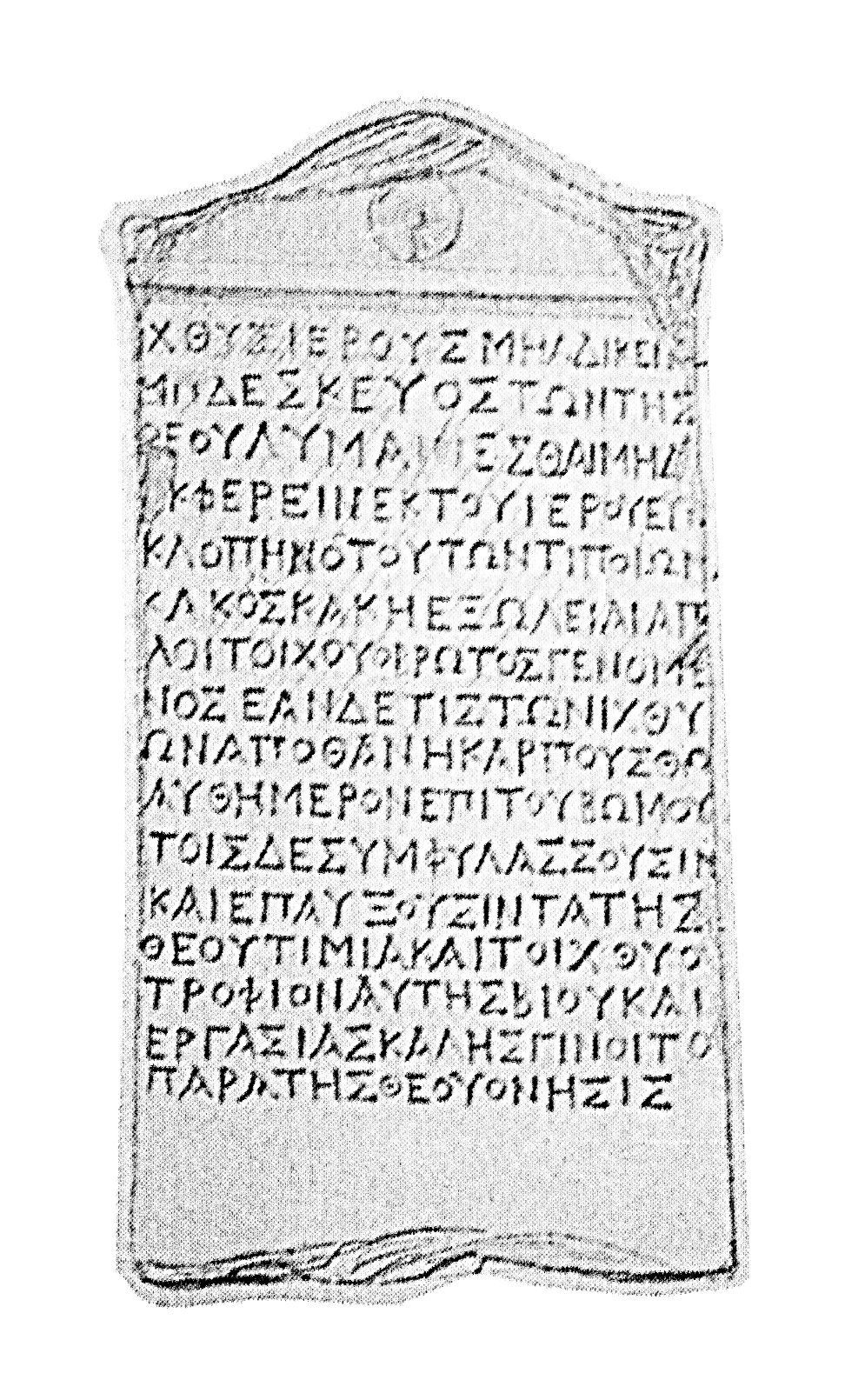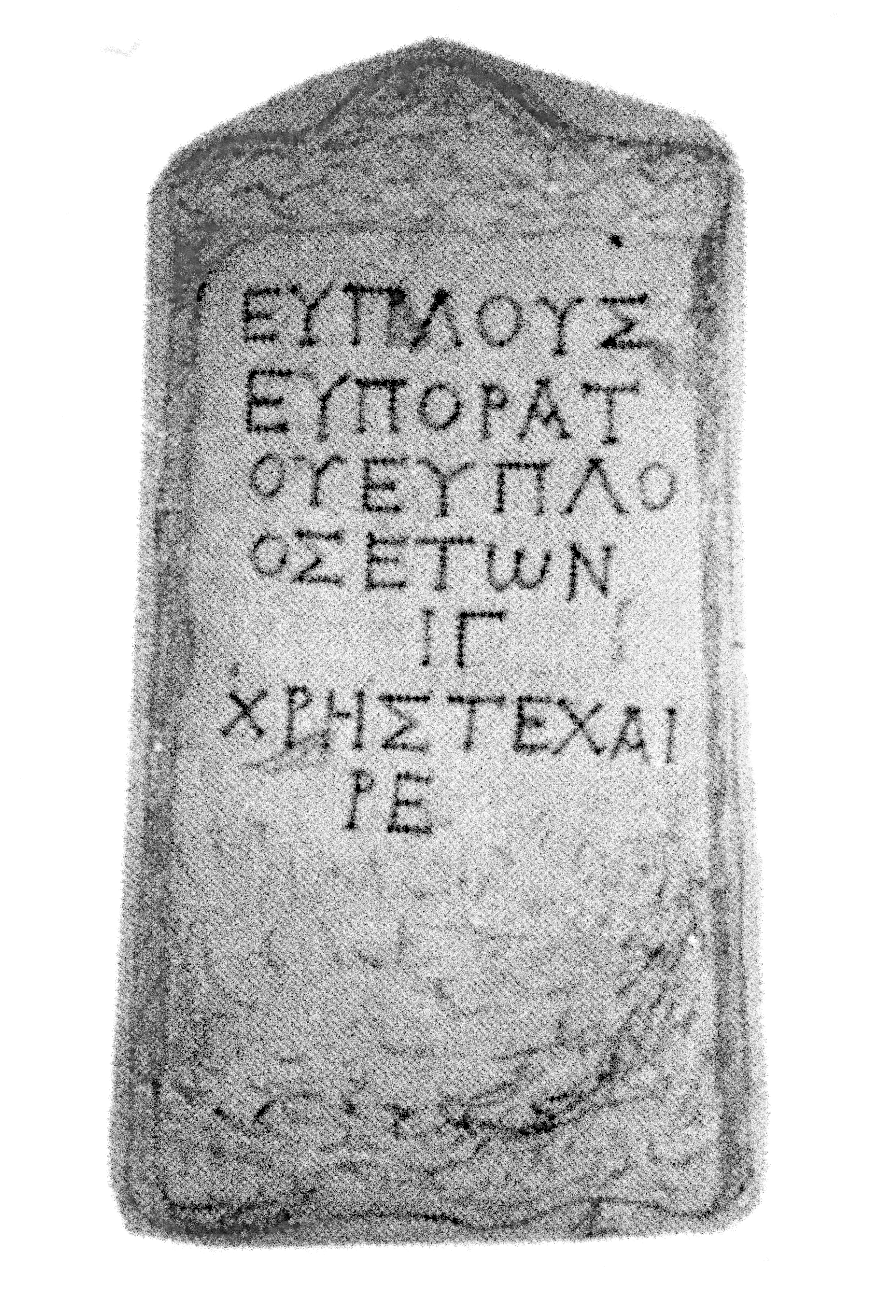BE = Bulletin Épigraphique in Revue des Études Grecques.
BE = Bulletin Épigraphique in Revue des Études Grecques.
Greek Ritual Norms = Carbon, J.-M.; Peels, S.; Pirenne-Delforge, V. (eds.) (2017). A Collection of Greek Ritual Norms (CGRN). Liège. [http://cgrn.ulg.ac.be/]. https://doi.org/10.54510/CGRN245
Greek Ritual Norms = Carbon, J.-M.; Peels, S.; Pirenne-Delforge, V. (eds.) (2017). A Collection of Greek Ritual Norms (CGRN). Liège. [http://cgrn.ulg.ac.be/]. https://doi.org/10.54510/CGRN245
Guarducci, Epigrafia greca IV = Guarducci, M. (1978). Epigrafia Greca IV. Epigrafi sacre pagane e cristiane. Roma.
Guarducci, Epigrafia greca IV = Guarducci, M. (1978). Epigrafia Greca IV. Epigrafi sacre pagane e cristiane. Roma.
I.Délos V = Roussel, P.; Launey, M. (éds.) (1937). Inscriptions de Délos V. Paris.
I.Délos V = Roussel, P.; Launey, M. (éds.) (1937). Inscriptions de Délos V. Paris.
I.Dura-Europos III = Baur, P.; Rostovtzeff, M.; Bellinger, A. (a cura di) (1932). The Excavations at Dura-Europos. Preliminary Reports. Third Season, 1929-1930. New Haven (= Dura-Europos).
I.Dura-Europos III = Baur, P.; Rostovtzeff, M.; Bellinger, A. (a cura di) (1932). The Excavations at Dura-Europos. Preliminary Reports. Third Season, 1929-1930. New Haven (= Dura-Europos).
I.Milet = (1997-2006) Milet VI. Inschriften von Milet,1-3. Berlin.
I.Milet = (1997-2006) Milet VI. Inschriften von Milet,1-3. Berlin.
I.Smyrna I = Petzl, G. (a cura di) (1982). Die Inschriften von Smyrna I. Bonn (IGSK 23).
I.Smyrna I = Petzl, G. (a cura di) (1982). Die Inschriften von Smyrna I. Bonn (IGSK 23).
I.Smyrna II = Petzl, G. (a cura di) (1990). Die Inschriften von Smyrna II vols. 1 und 2. Bonn (IGSK 24 1/2).
I.Smyrna II = Petzl, G. (a cura di) (1990). Die Inschriften von Smyrna II vols. 1 und 2. Bonn (IGSK 24 1/2).
I.Tralleis = Poljakov, Fj.B. (a cura di) (1989). Die Inschriften von Tralleis und Nysa, I. Die Inschriften von Tralleis. Bonn (IGSK 36 1).
I.Tralleis = Poljakov, Fj.B. (a cura di) (1989). Die Inschriften von Tralleis und Nysa, I. Die Inschriften von Tralleis. Bonn (IGSK 36 1).
IG XI.4 = Roussel, P. (ed.) (1914). Inscriptiones Graecae XI. Inscriptiones Deli, fasc. 4. Berlin (nos. 510-1349).
IG XI.4 = Roussel, P. (ed.) (1914). Inscriptiones Graecae XI. Inscriptiones Deli, fasc. 4. Berlin (nos. 510-1349).
LSAM = Sokolowski, F. (1955). Lois sacrées de l'Asie Mineure. Paris.
LSAM = Sokolowski, F. (1955). Lois sacrées de l'Asie Mineure. Paris.
Michel, Recueil = Michel, C. (éd.) (1897-1900). Recueil d'inscriptions grecques. Brussels (https://archive.org/search.php?query=michel%20recueil%20d%27inscriptions%20grecques).
Michel, Recueil = Michel, C. (éd.) (1897-1900). Recueil d'inscriptions grecques. Brussels (https://archive.org/search.php?query=michel%20recueil%20d%27inscriptions%20grecques).
New Doc. Early Christ. = Horsley, G.H.R. (ed.) (1987). New Documents Illustrating Early Christianity. Volume 4: A Review of the Greek Inscriptions and Papyri Published in 1979. North Ride, N.S.W.
New Doc. Early Christ. = Horsley, G.H.R. (ed.) (1987). New Documents Illustrating Early Christianity. Volume 4: A Review of the Greek Inscriptions and Papyri Published in 1979. North Ride, N.S.W.
SEG = (1923→) Supplementum Epigraphicum Graecum. Leiden.
SEG = (1923→) Supplementum Epigraphicum Graecum. Leiden.
Strubbe, Arai epitymbioi = Strubbe, J.H.M. (a cura di) (1997). ΑΡΑΙ ΕΠΙΤΥΜΒΙΟΙ. Imprecations against Desecrators of the Grave in the Greek Epitaphs of Asia Minor. A Catalogue. Bonn (IGSK 52).
Strubbe, Arai epitymbioi = Strubbe, J.H.M. (a cura di) (1997). ΑΡΑΙ ΕΠΙΤΥΜΒΙΟΙ. Imprecations against Desecrators of the Grave in the Greek Epitaphs of Asia Minor. A Catalogue. Bonn (IGSK 52).
Syll. I = Dittenberger, W. (a cura di) (1883). Sylloge Inscriptionum Graecarum, 1st ed. Vol. I. Ausg. Leipzig.
Syll. I = Dittenberger, W. (a cura di) (1883). Sylloge Inscriptionum Graecarum, 1st ed. Vol. I. Ausg. Leipzig.
Syll.² I = Dittenberger, W. (ed.) (1898-1901). Sylloge Inscriptionum Graecarum, Bd. I, 2. Ausg. Leipzig.
Syll.² I = Dittenberger, W. (ed.) (1898-1901). Sylloge Inscriptionum Graecarum, Bd. I, 2. Ausg. Leipzig.
Syll.³ III = Dittenberger, W. (ed.) (1920). Sylloge Inscriptionum Graecarum, Bd. III, 3. Ausg. Leipzig.
Syll.³ III = Dittenberger, W. (ed.) (1920). Sylloge Inscriptionum Graecarum, Bd. III, 3. Ausg. Leipzig.
Antonetti, C. (2004). «Fauna marina e tabù alimentari nel mondo greco». Grottanelli, C.; Milano, L. (a cura di), Food and Identity in the Ancient World. Padova, 165-77.
Antonetti, C. (2004). «Fauna marina e tabù alimentari nel mondo greco». Grottanelli, C.; Milano, L. (a cura di), Food and Identity in the Ancient World. Padova, 165-77.
Baslez, M.-F. (1977). Recherches sur les conditions de pénétration et de diffusion des religions orientales à Délos (IIe – Ier s. avant notre ère). Paris.
Baslez, M.-F. (1977). Recherches sur les conditions de pénétration et de diffusion des religions orientales à Délos (IIe – Ier s. avant notre ère). Paris.
Billows, R.A. (2007). «Rebirth of a Region: Ionia in the Early Hellenistic Period». Elton, H.; Reger, G. (éds.), Regionalism in Hellenistic and Roman Asia Minor. Acts of the Conference Hartford, Connecticut, August 22-24, 1997.. Pessac, 33-43. https://doi.org/10.4000/books.ausonius.1178.
Billows, R.A. (2007). «Rebirth of a Region: Ionia in the Early Hellenistic Period». Elton, H.; Reger, G. (éds.), Regionalism in Hellenistic and Roman Asia Minor. Acts of the Conference Hartford, Connecticut, August 22-24, 1997.. Pessac, 33-43. https://doi.org/10.4000/books.ausonius.1178.
Bruneau, Ph. (1970). Recherches sur les cultes de Délos à l’époque hellénistique et à l’époque imperiale. Paris.
Bruneau, Ph. (1970). Recherches sur les cultes de Délos à l’époque hellénistique et à l’époque imperiale. Paris.
Burkert, W. (1972). Homo Necans: Interpretationen altgriechischer Opferreiten und Mythen. Berlin.
Burkert, W. (1972). Homo Necans: Interpretationen altgriechischer Opferreiten und Mythen. Berlin.
Cadoux, T.J. (1938). Ancient Smyrna. Oxford.
Cadoux, T.J. (1938). Ancient Smyrna. Oxford.
Collin-Bouffier, S (1999). «La pisciculture dans le monde grec. État de la question». MEFR, 111, 37-50.
Collin-Bouffier, S (1999). «La pisciculture dans le monde grec. État de la question». MEFR, 111, 37-50.
Di Cesare, R. (2014). «L’altare arcaico ». Greco, E. (a cura di), Topografia di Atene, 3**. Agora del Ceramico. Atene, Paestum, 965-8.
Di Cesare, R. (2014). «L’altare arcaico ». Greco, E. (a cura di), Topografia di Atene, 3**. Agora del Ceramico. Atene, Paestum, 965-8.
Di Nicuolo, C. (2021). «Tra i neoria e le cinque stoai. Il Pireo e Afrodite». Pelargòs, 2, 109-46.
Di Nicuolo, C. (2021). «Tra i neoria e le cinque stoai. Il Pireo e Afrodite». Pelargòs, 2, 109-46.
Dölger, F.J. (1922). ΙΧΘΥΣ ΙΙ. Der Heilige Fisch in den antiken Religionen und im Christentum. Berlin.
Dölger, F.J. (1922). ΙΧΘΥΣ ΙΙ. Der Heilige Fisch in den antiken Religionen und im Christentum. Berlin.
Drijvers, H.W.J. (1980). Cults and Beliefs at Edessa. Leiden.
Drijvers, H.W.J. (1980). Cults and Beliefs at Edessa. Leiden.
Fontrier, A.M. (1873-1875). Μουσεῖον καὶ βιβλιοθήκη τῆς Εὐαγγελικῆς Σχολῆς. Σμύρνα.
Fontrier, A.M. (1873-1875). Μουσεῖον καὶ βιβλιοθήκη τῆς Εὐαγγελικῆς Σχολῆς. Σμύρνα.
Goossens, K. (1942). Hiérapolis de Syria. Paris.
Goossens, K. (1942). Hiérapolis de Syria. Paris.
Gruppe, O. (1906). Griechische Mythologie und Religionsgeschichte.
Gruppe, O. (1906). Griechische Mythologie und Religionsgeschichte.
Hörig, M. (1978). Dea Syria: Studien zur religiösen Tradition d. Fruchtbarkeitsgöttin in Vorderasien. Münster.
Hörig, M. (1978). Dea Syria: Studien zur religiösen Tradition d. Fruchtbarkeitsgöttin in Vorderasien. Münster.
Hörig, M. (2016). «Dea Syria - Atargatis». ANRW 17.3: Religion. Heidentum: Römische Götterkulte, Orientalische Kulte in der römischen Welt, Fortsetzung. Berlin, Boston, 1536-82.
Hörig, M. (2016). «Dea Syria - Atargatis». ANRW 17.3: Religion. Heidentum: Römische Götterkulte, Orientalische Kulte in der römischen Welt, Fortsetzung. Berlin, Boston, 1536-82.
Icard, N.; Szabados, A.V. (2014). «Le poisson dans la Grèce ancienne : un aliment déconsidéré». Costamagno, S. (éd.), Histoire de l’alimentation humaine : entre choix et contraintes. Actes du 138e Congrès national des sociétés historiques et scientifiques, « Se nourrir : pratiques et stratégies alimentaires », Rennes, 2013. Paris, 250-64. https://www.persee.fr/issue/acths_1764-7355_2014_act_138_2.
Icard, N.; Szabados, A.V. (2014). «Le poisson dans la Grèce ancienne : un aliment déconsidéré». Costamagno, S. (éd.), Histoire de l’alimentation humaine : entre choix et contraintes. Actes du 138e Congrès national des sociétés historiques et scientifiques, « Se nourrir : pratiques et stratégies alimentaires », Rennes, 2013. Paris, 250-64. https://www.persee.fr/issue/acths_1764-7355_2014_act_138_2.
Janell, W. (1906). Ausgewählte Inschriften. Berlin.
Janell, W. (1906). Ausgewählte Inschriften. Berlin.
Kern, O. (1938). Die Religion der Griechen.
Kern, O. (1938). Die Religion der Griechen.
Lambrechts, P.; Noven, P. (1954). «Recherches sur le culte d’Atargatis dans le monde grec». NClio, 6, 258-77.
Lambrechts, P.; Noven, P. (1954). «Recherches sur le culte d’Atargatis dans le monde grec». NClio, 6, 258-77.
Lefèvre-Novaro, D. (2010). «Les sacrifices de poisons dans les sanctuaires grecs de l’Âge du Fer». Kernos, 23, 37-52.
Lefèvre-Novaro, D. (2010). «Les sacrifices de poisons dans les sanctuaires grecs de l’Âge du Fer». Kernos, 23, 37-52.
Lefèvre-Novaro, D.; Mouton, A. (2008). «Aux origines de l’ichthyomancie en Anatolie Ancienne. Sources textuelles et données archéologiques». Anatolica, 34, 7-52.
Lefèvre-Novaro, D.; Mouton, A. (2008). «Aux origines de l’ichthyomancie en Anatolie Ancienne. Sources textuelles et données archéologiques». Anatolica, 34, 7-52.
Lightfoot, J. (2003). Lucian. On the Syrian Goddess (edited with introduction, traduction and commentary by). Oxford.
Lightfoot, J. (2003). Lucian. On the Syrian Goddess (edited with introduction, traduction and commentary by). Oxford.
McCabe, D.F. (1988). Smyrna Inscriptions. Texts and List. Princeton.
McCabe, D.F. (1988). Smyrna Inscriptions. Texts and List. Princeton.
Meyer, M. (2010). «Die Aphrodite Stratonikis in Smyrna und die Asylie der Stadt». JNG, 40, 35-70.
Meyer, M. (2010). «Die Aphrodite Stratonikis in Smyrna und die Asylie der Stadt». JNG, 40, 35-70.
Morin, P.J. (1960). The cult of Dea Syria in the Greek World. Columbus [Dissertation]. Ohio State University.
Morin, P.J. (1960). The cult of Dea Syria in the Greek World. Columbus [Dissertation]. Ohio State University.
Muccioli, F. (2019). «Smirne e il culto di Afrodite Stratonikis, tra i Seleucidi e Roma». Panichi, S. (a cura di), Dall’Egeo all’Eufrate: dinasti, città e santuari in età ellenistica. Settimo seminario di Geographia Antiqua (Perugia, 8 giugno 2018). Firenze, 47-54.
Muccioli, F. (2019). «Smirne e il culto di Afrodite Stratonikis, tra i Seleucidi e Roma». Panichi, S. (a cura di), Dall’Egeo all’Eufrate: dinasti, città e santuari in età ellenistica. Settimo seminario di Geographia Antiqua (Perugia, 8 giugno 2018). Firenze, 47-54.
Muriel, R.J.G. (2021). Contaminacion religiosa en la Grecia arcaica y clasica: estudio critico de fuentes. Barcelona [Dissertation]. Universitat de Barcelona.
Muriel, R.J.G. (2021). Contaminacion religiosa en la Grecia arcaica y clasica: estudio critico de fuentes. Barcelona [Dissertation]. Universitat de Barcelona.
Nilsson, M.P. (1950). Geschichte griechichen Religion, II. München.
Nilsson, M.P. (1950). Geschichte griechichen Religion, II. München.
Osanna, M. (1989). «Il problema topografico del santuario di Afrodite Urania ad Atene». ASAA, 66-67, 73-95.
Osanna, M. (1989). «Il problema topografico del santuario di Afrodite Urania ad Atene». ASAA, 66-67, 73-95.
Pfohl, G. (Hrsg) (1980). Griechische Inschriften als Zeugnisse des privatens und öffentlichen Lebens. Berlin (2. Auflage).
Pfohl, G. (Hrsg) (1980). Griechische Inschriften als Zeugnisse des privatens und öffentlichen Lebens. Berlin (2. Auflage).
Pirenne-Delforge, V. (1994). L’Aphrodite Grecque . Athènes-Liège.
Pirenne-Delforge, V. (1994). L’Aphrodite Grecque . Athènes-Liège.
Reese, D. (1989). «Faunal Remains from the Altar of Aphrodite Ourania, Athens». Hesperia, 58, 63-70.
Reese, D. (1989). «Faunal Remains from the Altar of Aphrodite Ourania, Athens». Hesperia, 58, 63-70.
Reinach, S. (a cura di) (1885). Traité d’épigraphie grecque. Paris https://archive.org/details/traitdpigraphie00newtgoog.
Reinach, S. (a cura di) (1885). Traité d’épigraphie grecque. Paris https://archive.org/details/traitdpigraphie00newtgoog.
Rosenzweig, R. (2004). Worshipping Aphrodite: Art and Cult in Classical Athens. Ann Arbor.
Rosenzweig, R. (2004). Worshipping Aphrodite: Art and Cult in Classical Athens. Ann Arbor.
Siebert, G. (1958). «Sur l’histoire du sanctuaire des dieux syriens à Délos». BCH, 92, 359-74.
Siebert, G. (1958). «Sur l’histoire du sanctuaire des dieux syriens à Délos». BCH, 92, 359-74.
Tod, M.N. (1956). «Lois sacrées de l’Asie Mineure by Franciszek Sokolowski». Gnomon, 28, 455-61.
Tod, M.N. (1956). «Lois sacrées de l’Asie Mineure by Franciszek Sokolowski». Gnomon, 28, 455-61.
Van Berg, P.-L. (1972). Corpus Cultus Deae Syriae. Leiden.
Van Berg, P.-L. (1972). Corpus Cultus Deae Syriae. Leiden.
Weber, M. (2006). «Die Kultbilder der Aphrodite Urania der zweiten Hälfte des 5. Jhs. v. Chr. in Athena/Attika und das Bürgerrechtsgesetz von 451/0 v.Chr». MDAI(A), 121, 165-79.
Weber, M. (2006). «Die Kultbilder der Aphrodite Urania der zweiten Hälfte des 5. Jhs. v. Chr. in Athena/Attika und das Bürgerrechtsgesetz von 451/0 v.Chr». MDAI(A), 121, 165-79.
Will, E. (1985). Le Sanctuaire de la Déesse Syrienne. Paris.
Will, E. (1985). Le Sanctuaire de la Déesse Syrienne. Paris.
Michel, Recueil = Michel, C. (éd.) (1897-1900). Recueil d'inscriptions grecques. Brussels (https://archive.org/search.php?query=michel%20recueil%20d%27inscriptions%20grecques).
Reinach, S. (a cura di) (1885). Traité d’épigraphie grecque. Paris https://archive.org/details/traitdpigraphie00newtgoog.
Janell, W. (1906). Ausgewählte Inschriften. Berlin.
Pfohl, G. (Hrsg) (1980). Griechische Inschriften als Zeugnisse des privatens und öffentlichen Lebens. Berlin (2. Auflage).
Reinach, S. (a cura di) (1885). Traité d’épigraphie grecque. Paris https://archive.org/details/traitdpigraphie00newtgoog.
Michel, Recueil = Michel, C. (éd.) (1897-1900). Recueil d'inscriptions grecques. Brussels (https://archive.org/search.php?query=michel%20recueil%20d%27inscriptions%20grecques).
Janell, W. (1906). Ausgewählte Inschriften. Berlin.
Pfohl, G. (Hrsg) (1980). Griechische Inschriften als Zeugnisse des privatens und öffentlichen Lebens. Berlin (2. Auflage).
Michel, Recueil = Michel, C. (éd.) (1897-1900). Recueil d'inscriptions grecques. Brussels (https://archive.org/search.php?query=michel%20recueil%20d%27inscriptions%20grecques).
Reinach, S. (a cura di) (1885). Traité d’épigraphie grecque. Paris https://archive.org/details/traitdpigraphie00newtgoog.
Janell, W. (1906). Ausgewählte Inschriften. Berlin.
Syll.³ III = Dittenberger, W. (ed.) (1920). Sylloge Inscriptionum Graecarum, Bd. III, 3. Ausg. Leipzig.
LSAM = Sokolowski, F. (1955). Lois sacrées de l'Asie Mineure. Paris.
Guarducci, Epigrafia greca IV = Guarducci, M. (1978). Epigrafia Greca IV. Epigrafi sacre pagane e cristiane. Roma.
Reinach, S. (a cura di) (1885). Traité d’épigraphie grecque. Paris https://archive.org/details/traitdpigraphie00newtgoog.
Janell, W. (1906). Ausgewählte Inschriften. Berlin.
Reinach, S. (a cura di) (1885). Traité d’épigraphie grecque. Paris https://archive.org/details/traitdpigraphie00newtgoog.
Janell, W. (1906). Ausgewählte Inschriften. Berlin.
I.Smyrna II = Petzl, G. (a cura di) (1990). Die Inschriften von Smyrna II vols. 1 und 2. Bonn (IGSK 24 1/2).
I.Smyrna II = Petzl, G. (a cura di) (1990). Die Inschriften von Smyrna II vols. 1 und 2. Bonn (IGSK 24 1/2).
| 















